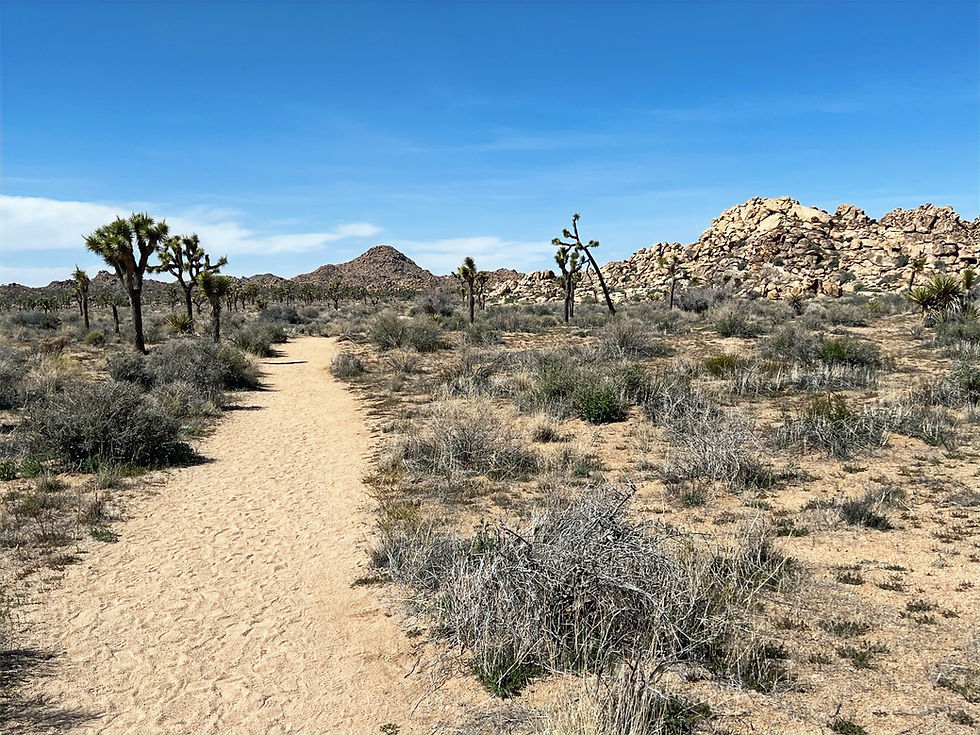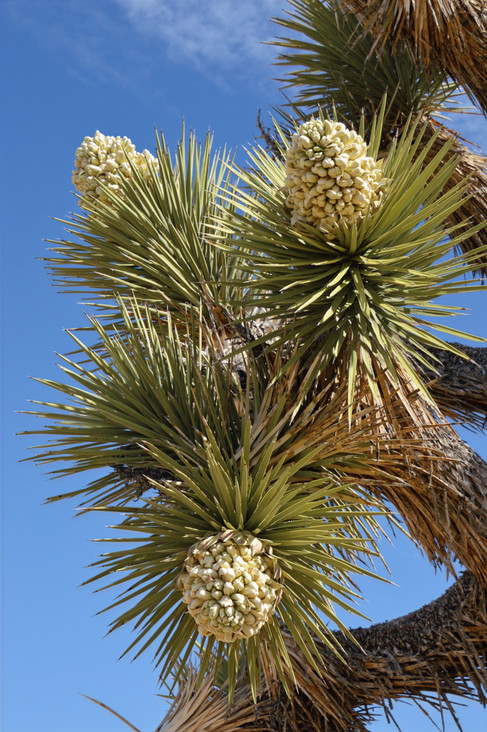Joshua Tree's Quiet Corridor: Hiking the Boy Scout Trail
- Steve

- Apr 6, 2024
- 4 min read
Unlike most of the hiking blogs on our site, the Boy Scout Trail post showcases the photos from our partial hike of this classic trail in Joshua Tree National Park. The trail is an 8-mile point to point but we chose to complete a portion of it as an out and back. We weren’t looking to chalk up a 16 mile hike so we just hiked until we decided to turn around. No matter how you hike Boy Scout it’s an enjoyable adventure.
Hike Distance: 9.8 miles
Elevation Gain: 494 ft elevation gain
TrailsNH Hiking Difficulty Calculator: 94 – Moderate
Click here to navigate to the TrailsNH website for a description of the hiking difficulty calculator.

The trail head for the Boy Scout Trail is located at a signed parking lot on Park Blvd about 11+ miles from the West Entrance of the park.

Mojave Kingcup Cactus is commonly found within the park boundaries. This large Kingcup only had a few small blooms but a smaller plant a short distance away had several large showy flowers.


We were lucky because many of the Joshua trees along the trails were in bloom during our early April hike. Joshua trees don't flower annually; their blooming is irregular and influenced by various environmental and biological factors. Generally, they bloom every 2 to 3 years, but some trees might not flower for 5 years or more. Incredibly, flowering typically starts when a tree is 30-50 years old. While mass flowering events like what we observed can happen over wide areas, they are rare.

Joshua trees are pollinated exclusively by the yucca moth. These moths and trees have a mutualistic relationship: the moth lays its eggs in the flower while also pollinating it. If pollination is successful, the Joshua tree produces seed pods by summer. Whether or not a flower produces seed depends entirely on the activity of its yucca moth pollinator. After flowering, the tree enters a recovery phase, often delaying its next flowering cycle for several years.
Fiddlesticks were blooming along a initial section of the trail as it weaved through a sandy wash. The plant’s common name is derived from the flower stems which curl over the top in a way that resembles the head of a fiddle.
The cholla's skeleton is a remarkable example of natural engineering; built for survival in harsh conditions and exhibiting exceptional durability even after the plant itself has died. The skeleton can remain standing for a considerable time and is often used as shelter by desert animals.

At first glance, it’s easy to confuse Joshua trees with their close relative, the Mojave yucca. The key differences between a Mojave yucca and a Joshua tree lie in their leaf length and the presence of curling fibers on the leaves. Mojave yuccas have much longer leaves (up to four times longer) than Joshua trees, and their leaves have curling fibers that peel away from the edges. Joshua tree leaves are shorter, thinner, and lack these peeling fibers. Additionally, while both are in the yucca family, Mojave yuccas tend to stay shorter and grow in clumps, whereas Joshua trees are known for their taller, branching structure.

Joshua trees typically don't branch until after they bloom. The blooming process damages the terminal bud growing tip which prompts the tree to split into two new branches. Branches continue to grow until they bloom and branch again, leading to the tree's overall form. Some trees, however, may never bloom and remain as single, unbranched stalks.

After the first few miles, the terrain begins to transition from a flat desert landscape to the classic Joshua Tree rock country.

Around the 3 mile mark, you enter the ‘Wonderland of Rocks’ area famous for its maze of towers granite formations and massive rock piles.


California junipers in the park grow at a slow pace, generally reaching heights between 3 and 15 feet, though some can grow as tall as 40 feet. They flourish in open, sunny locations with well-drained soils and can endure with minimal water, which results in their slow growth. Even though they have a lengthy growing season, their height only increases by approximately 2 to 4 inches annually because of the limited water supply. Their twisted growth and rigid branches equip them well for the harsh landscape. Juvenile trees have needle-like leaves, which mature into overlapping, scale-like leaves. This form minimizes water loss, which is beneficial in the dry, windy environments of Joshua Tree. Many juniper species are encroaching on drier habitats and becoming more prevalent where they already exist by enduring droughts that pinyon pines and other conifers cannot withstand.

Juniper berries, despite their name, are not true berries but rather female seed cones. These cones have fleshy, fused scales, giving them a berry-like look. Initially green, they take 1–3 years to mature into a blue or blue-black color. It's common for a tree to have berries in different stages of ripeness. They are best known for their role in flavoring gin. It's typical for a tree to bear berries at various stages of ripeness. Juniper berries are most recognized for their use in flavoring gin. If you crush a ripe juniper berry, it releases a strong gin-like scent.

Indian Paintbrush were in bloom.

What looks like a cactus clinging to life in a barren crack is probably a plant in its prime spot since it has fewer competitors for limited water and nutrients. In addition, these cracks trap water from brief desert showers, funneling it toward the roots instead of letting it evaporate immediately from bare rock surfaces. The rocks themselves buffer temperature swings: they warm slowly in the morning and release heat at night, protecting seedlings from freezing or scorching temperatures.

We actually spotted the cactus as we were climbing a large rock pile for a shady lunch spot with...

... great views.

While the trail does traverse several sandy washes, this part of the Boy Scout trail mainly consists of rocky terrain..


We continued on the trail until mile 4.9 and then turned around to head back to the trailhead.

We completed the hike at just under 10 miles. It was yet another amazing day discovering all that Joshua Tree National Park has to offer.

060423











Comments